My previous two articles covered pitchers whose interesting pitchers made them outliers. We'll now shift to hitters, starting with plate discipline outliers, using chase rates as a way to identify patient and aggressive hitters. Though we ideally want hitters who don't chase while making high levels of contact in the strike zone, not every hitter can fit that mold. For this article, we'll focus on two particularly patient hitters and two particularly aggressive ones, all four of which make for intriguing picks this winter.
Patient Hitters
Among hitters with 50 plate appearances, Evan Carter, Edouard Julien, Robbie Grossman, Cavan Biggio and Michael Stefanic had the lowest chase rates. Five other hitters rounded out a group of 10 players who boasted a chase rate of 20 percent or below, including Travis Jankowski, Davis Schneider, Zack Short, Juan Soto and Mookie Betts. With rounding, Darin Ruf and Lars Nootbaar would fit the bill too. The visual below shows those players with the best chase rates, including their respective swing rates inside and outside the zone:
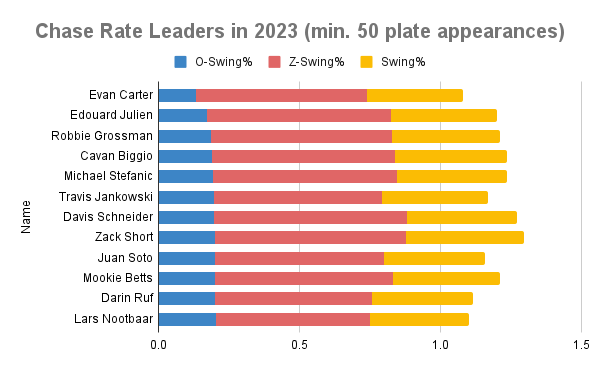
Interestingly, these same hitters tend to be more aggressive when they swing in the zone, with most of them toward the middle of the pack among the 542 qualified hitters. Stefanic, Jankowski, Soto and Betts have 90 percent zone contact rates or higher. That indicates they likely have above-average hit tools both in terms of making contact and in recognizing when to swing. Don't sleep on Biggio and Grossman's zone contact
My previous two articles covered pitchers whose interesting pitchers made them outliers. We'll now shift to hitters, starting with plate discipline outliers, using chase rates as a way to identify patient and aggressive hitters. Though we ideally want hitters who don't chase while making high levels of contact in the strike zone, not every hitter can fit that mold. For this article, we'll focus on two particularly patient hitters and two particularly aggressive ones, all four of which make for intriguing picks this winter.
Patient Hitters
Among hitters with 50 plate appearances, Evan Carter, Edouard Julien, Robbie Grossman, Cavan Biggio and Michael Stefanic had the lowest chase rates. Five other hitters rounded out a group of 10 players who boasted a chase rate of 20 percent or below, including Travis Jankowski, Davis Schneider, Zack Short, Juan Soto and Mookie Betts. With rounding, Darin Ruf and Lars Nootbaar would fit the bill too. The visual below shows those players with the best chase rates, including their respective swing rates inside and outside the zone:

Interestingly, these same hitters tend to be more aggressive when they swing in the zone, with most of them toward the middle of the pack among the 542 qualified hitters. Stefanic, Jankowski, Soto and Betts have 90 percent zone contact rates or higher. That indicates they likely have above-average hit tools both in terms of making contact and in recognizing when to swing. Don't sleep on Biggio and Grossman's zone contact skills, though that pair tends to lack fantasy juice.
Patient Hitters to Target
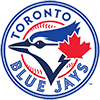 Davis Schneider, 2B, Blue Jays
Davis Schneider, 2B, Blue Jays
Davis Schneider debuted for the Blue Jays last season and showed a patient approach, as evidenced by his 19.8 percent chase rate, which came in 12 points below the league average. Though Schneider struggles to make contact with a 73 percent zone contact rate, he posts strong exit velocity numbers. Schneider's 17.8 percent barrel rate on contact and 9.2 percent barrels per plate appearance were both more than double the league average.
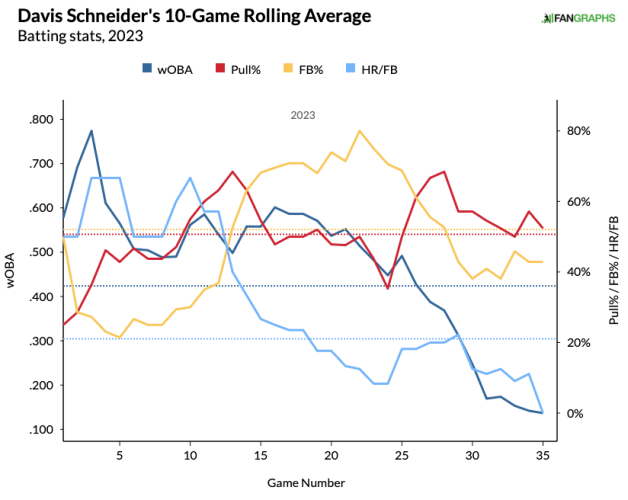
Schneider taps into his pull-side power with a 50.7 percent pull rate and 52.1 percent flyball rate, as seen above. His power looks sustainable even if we bake in some HR/FB regression, while he tends to use a selective and patient approach. One wild card of Schneider's profile involves his speed. He has average to above-average speed but lacked the opportunities during his time in the majors, attempting just one steal in 35 major-league games.
It's rare to find a player who projects for regular playing time in the middle of an above-average lineup going late in the draft. Schneider may play better in OBP leagues, but he's still worth targeting in batting average formats.
 Lars Nootbaar, OF, Cardinals
Lars Nootbaar, OF, Cardinals
Heading into last season, Lars Nootbaar showed the skills to have a breakout year. Unfortunately, Nootbaar battled thumb (April), back (May-June) and abdomen (August) injuries that likely contributed to his dip in power. However, he battled through and set career highs in plate appearances and several other categories. Nootbaar combines an elite chase rate with above-average contact rates:
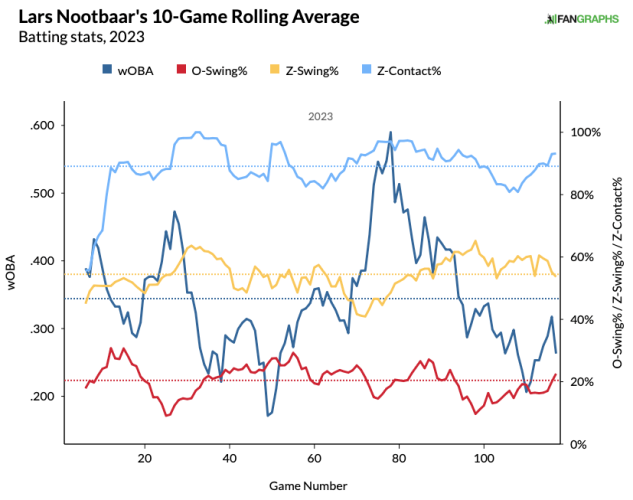
He boasts the 12th-lowest chase rate at 20.4 percent, with a zone contact rate nearly four points higher than the league average at 89.1 percent. Nootbaar's power dipped partly due to an increase in groundballs (49.7 percent), which were up almost six points from 2022. It's likely that his injuries were connected to the bump in ground balls, leading to lower barrel rates. Thankfully, Nootbaar continues to crush flyballs and line drives, with a 94.7 mph average exit velocity on those batted ball types (76th-best in the league), dipping from 96 mph (27th-best) in 2022.
Assuming health, expect a bounceback in Nootbaar's power skills, allowing him to push for 20 home runs. Keep tabs on his platoon splits, as he had a .835 OPS against righties and a .635 OPS versus lefties last season. Sometimes platoon splits can be noisy, given their small samples, and Nootbaar possesses the plate discipline floor, power skill upside and athleticism to make him a compelling pick despite his issues against lefties. It's reasonable to expect 20 home runs and double-digit stolen bases with a solid batting average, similar to a hitter like Ian Happ.
Aggressive Hitters
Instead of focusing purely on chase rates, we'll define aggressive hitters as ones who swing most often, which includes swing rates both inside and outside the zone. Hanser Alberto, Trey Cabbage, Jorge Alfaro, Tomas Nido, Mickey Moniak, Corey Dickerson, Salvador Perez and Christian Arroyo had overall swing rates of 60 percent or higher in 2023.
Alberto and Alfaro tend to rank highly on this list, with Moniak having some ups and downs, mostly via batted-ball luck. The visual below shows the swing rates of the most aggressive hitters, including how often they chase:
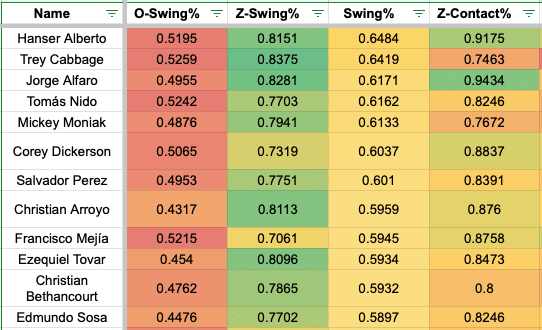
Alberto had a 91.8 percent zone contact rate with Alfaro at 94.3 percent, indicating their ability to make contact when they swing at pitches they can actually hit. Alfaro's name seems interesting since we typically haven't seen that in his profile, evidenced by his career zone contact rate of 78.1 percent. Unfortunately, it's likely small-sample noise, as Alfaro only logged 52 plate appearances last season in limited playing time with the Red Sox and Rockies.
Aggressive Hitters to Target
 Ezequiel Tovar, SS, Rockies
Ezequiel Tovar, SS, Rockies
The Rockies' shortstop posted a 45.4 percent chase rate, which ranked 522nd out of 543 hitters with at least 50 plate appearances. In other words, Tovar rocks the 21st-highest chase rate in the league, which can mean a lower floor due to an abundance of strikeouts. However, Tovar also swings at pitches in the zone at the 10th-highest rate (81 percent). A look at the leaders in Z-Swing% shows some of the better hitters in the league, though it's a mixed bag:
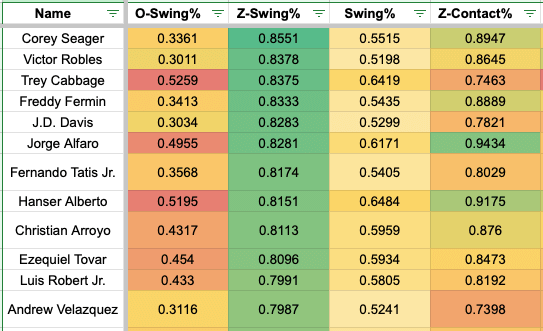
Notable names on the above leaderboard include Corey Seager (first), J.D. Davis (fifth), Fernando Tatis Jr. (seventh) and Luis Robert, who came in right behind Tovar in 11th. A good list of filters usually provides a mixture of actionable and fluky names, and there are of course some lesser names mixed in with that group as well. Still, the fact that Tovar makes contact at a league-average rate at pitches in the zone despite swinging at those pitches far more than average is encouraging.
It's not as drastic as Tovar's zone swing rate, but Tim Anderson comes to mind as a player with a similar profile. Anderson recorded a league-average zone contact rate last season paired with a career-high chase rate of 41 percent and a zone swing rate of 74.1 percent. Tovar seems to have the hit tool to overcome the aggressive approach like Anderson, so soak up Tovar's suppressed ADP inside the top 200.
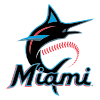 Jake Burger, 3B, Marlins
Jake Burger, 3B, Marlins
Injuries derailed Jake Burger's career until last season. Most of Burger's production came with the White Sox, though his batting average ballooned after a trade to Miami, mainly due to luck. After recording a .225 BABIP with Chicago, Burger's .354 BABIP in Miami boosted his batting average from .214 to .303. That seems clearly a bit fluky, so we should bake in regression in his BABIP going forward. Interestingly, or maybe expectedly, Burger's home run rate fell from 32.1 percent with the White Sox to 16.1 percent with the Marlins. The rolling graph below shows the impact of Burger's HR/FB rate and BABIP, two stats which measure luck to a large extent, on his wOBA:
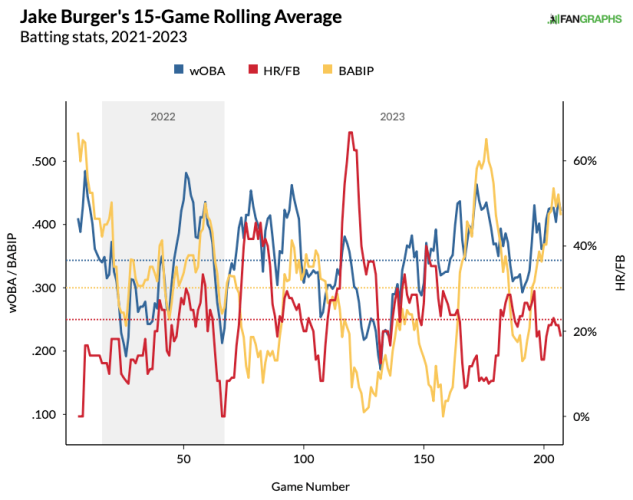
Luck factors aside, Burger used a slightly more aggressive approach with the Marlins. As seen in the rolling graph below, Burger's chase rate fell two points, while he began swinging more in the zone. Burger's zone swing rate went from right under 70 percent with the White Sox to 75.8 percent with the Marlins:
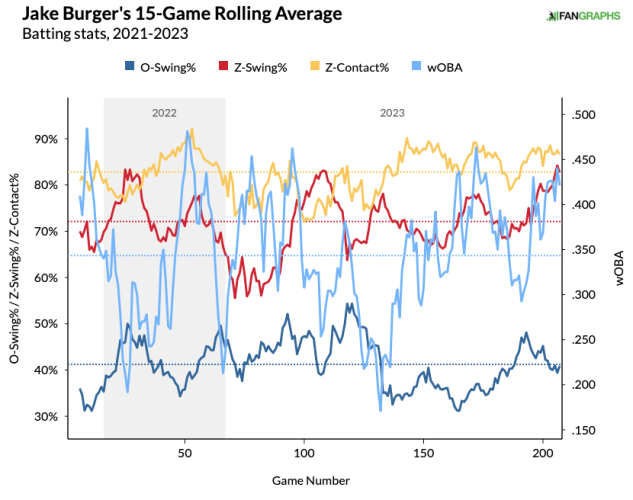
He swung more often in the zone and increased his zone contact rate by more than four points, which also contributed to his better batting average. Burger crushes the baseball, which can help offset a high strikeout rate, and his xBA in both the first half (.264) and the second half (.266) hinted at better actual results. Though like Cal Raleigh and other hitters who use a pull-heavy (49 percent) flyball (38.6 percent) approach, it doesn't always bode well for batting average.
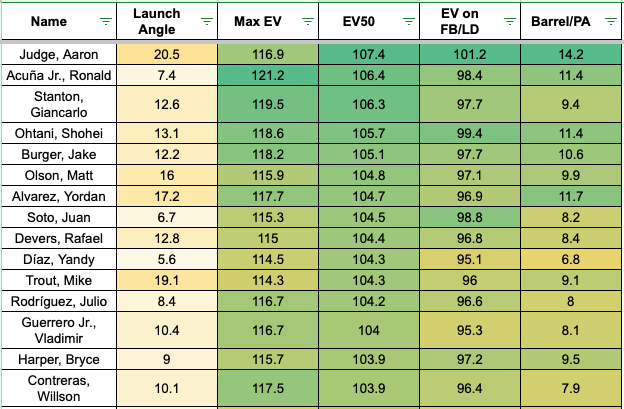
Regardless, Burger's power is legitimate, evident by his seventh-place ranking in exit velocity on flyball and line drives (97.7 mph) and his fifth-place ranking in Baseball Savant's new EV50 metric (105.1 mph). The EV50 metric is defined as the average of the hardest 50 percent of the hitter's batted balls. That gives us another exit velocity data point to consider, similar to maximum exit velocity but covering a larger sample. A repeat of 2023 for Burger seems likely given his elite power skills and his aggressive approach in the zone.







































